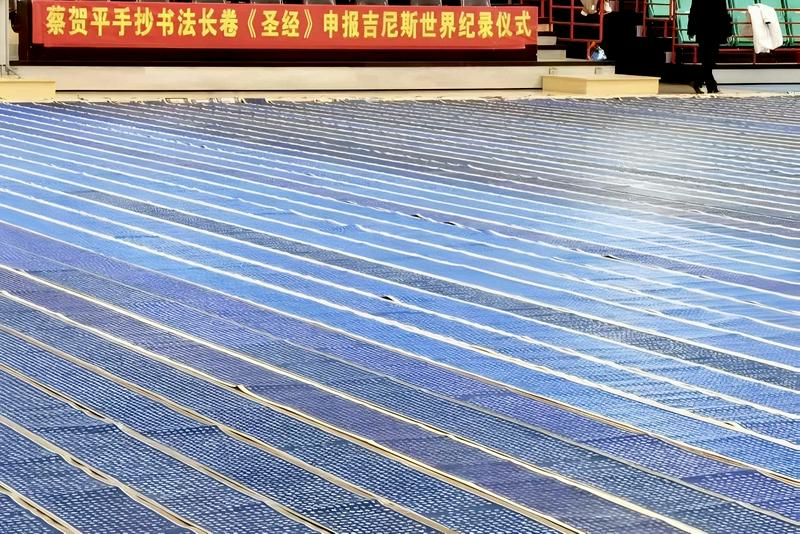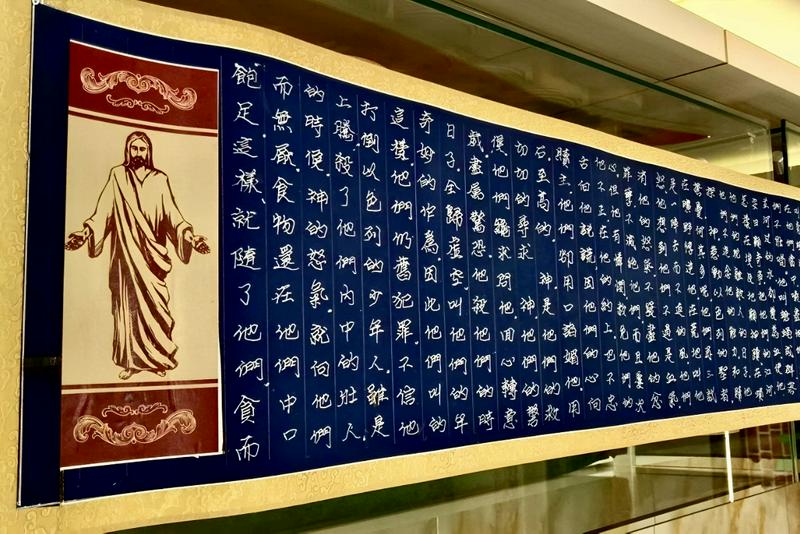A handwritten scroll of Bible calligraphy spanning more than 2,600 meters long was presented to apply for a Guinness World Record last Wednesday.
On February 19, in the stadium of Benxi City, Liaoning Province, the application ceremony for Mr. Cai Heping's handwritten calligraphy Bible for Guinness World Records was launched.
Cai Heping, a member of Chinese Hard-Pen Calligrapher Association, director of Liaoning Calligrapher Association, and vice president of Chinese Calligraphy and Painting Art Research Institute, began to copy Chinese and foreign classics in calligraphy form in the early 1980s, and is the first writer in China to copy the Dream of Red Mansions, All Men Are Brothers, Journey to the West and Romance of the Three Kingdoms in calligraphy form.
With a total length of nearly 2,700 meters, the handwritten Bible scroll is currently the longest handwritten Bible in the world. It consists of 91 volumes, each nearly 30 meters long. He chose to write in semi-cursive script and traditional Chinese characters, formatting the text in vertical columns on semi-mature "wannianlan" rice paper. To ensure that Chinese diaspora could read and understand the Bible, he insisted on writing the book in traditional Chinese characters.
Mr. Cai is known as "the first person in China to copy Chinese and foreign classics by hand." For more than 20 years, dozens of media across the country have followed up on Mr. Cai's copying of Chinese and foreign classics by hand.
In the process of handwriting the Bible, he studied the biblical texts deeply and found that the spiritual core contained in them, such as love, joy, peace, patience, kindness, goodness, faithfulness, forgiveness, and salvation, was highly consistent with the essence of traditional Chinese culture. Although not a Christian, he hoped to copy a classic work that would have a profound impact on mankind through the unique art of calligraphy in the East. He believes that the Bible, as a great epic, is full of ideals and humanity, showing the true meaning of life.
During the process, Mr. Cai suffered from a variety of ailments, including poor eyesight and extreme strain on his cervical and lumbar vertebrae, but he devoted himself to the work of transcribing the vast words of the Bible.
In 2020, he experienced a rential hemorrhage due to high blood sugar, high blood pressure, and staying up late for years. Although his vision was impaired after treatment, requiring him to use a magnifying glass to read, he persisted in his work. With a magnifying glass in his left hand and a pen in his right, he continued to copy texts.
In order to complete the work more intently, he rented a cottage in the countryside near Benxi City, with no television and no entertainment, only the original text of the Bible, a lamp, and silence. For six years, more than 2,000 days and nights, he washed his hands thousands of times to copy the Bible.
In June 2024, his work was finally released. Each word in the book is about four square centimeters. Each roll is 33 centimeters wide and nearly 30 meters long.
From A Dream of Red Mansions to the Bible, Mr. Cai has written more than 20 million words in 40 years, and the total weight of his works exceeds a ton.
(Originally published by the Gospel Times, the article has been edited under permission and the author is a Christian contributor in Liaoning Province. )
- Edited by Karen Luo, translated by Nicolas Cao













